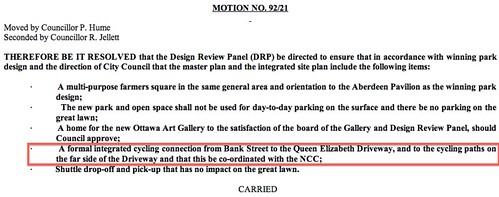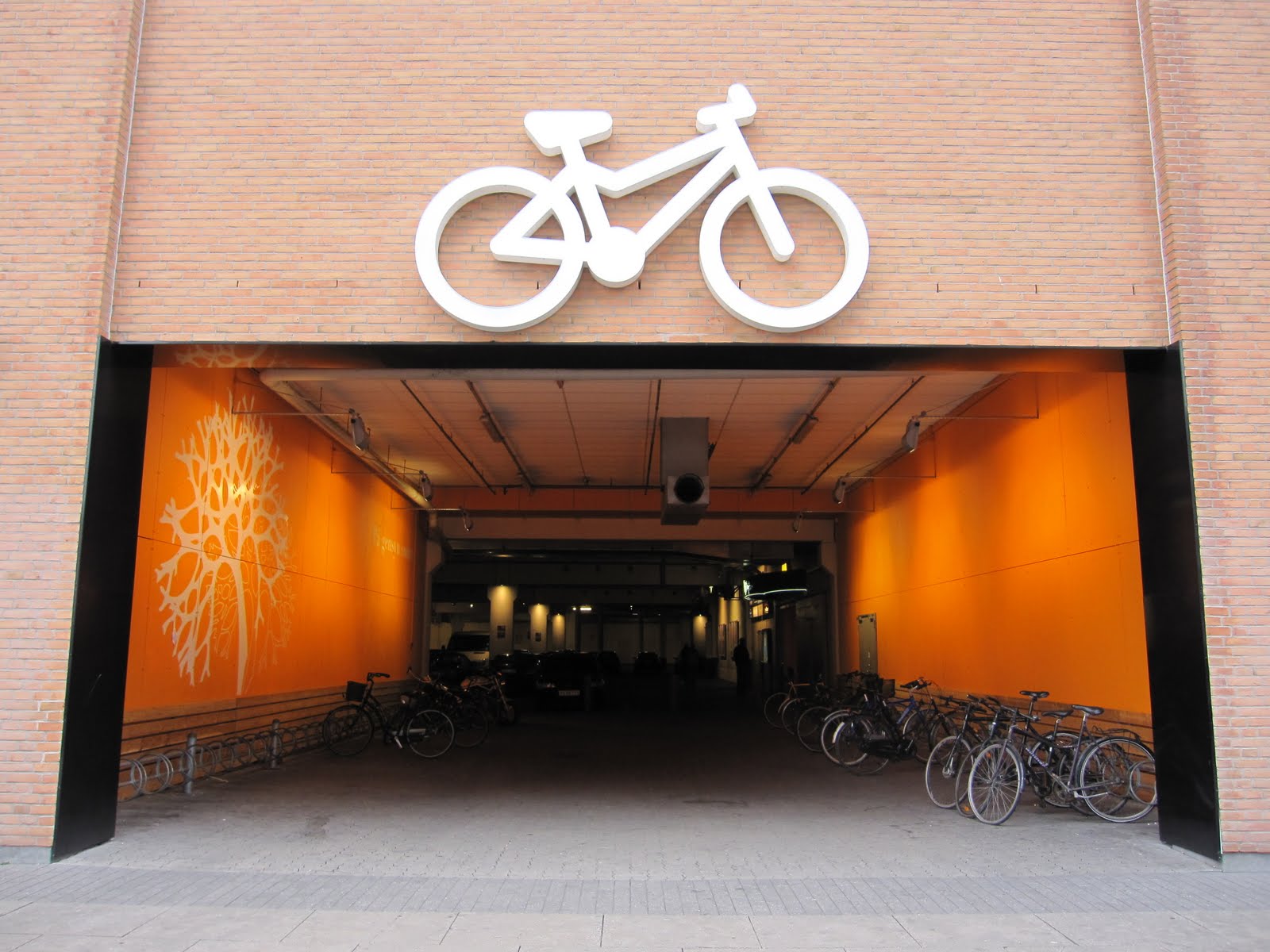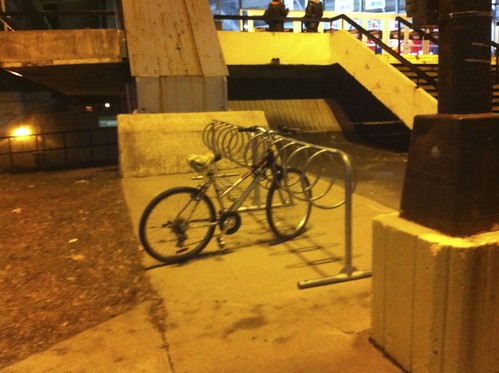
Over the last week, on my own blog I’ve been writing about details of the cycling aspect of the Lansdowne transportation plans. Those five articles are all pretty deep; this one will summarize the situation. This is all relevant for tonight’s open house on the topic.
The Lansdowne Park stadium in Ottawa is scheduled to be reconstructed over the next few years. The location in the Glebe, just south of downtown, makes it impossible to build new transportation infrastructure, yet the commercial success of the park depends on there being a lot more people visiting. To add to the problems, the local roads and parking are already clogged, particularly on Bank St.
My focus is on the biking aspects. Cycling is an important part of the transportation plan as it offsets other expensive types (driving, transit).

There’s an expectation that for larger events (like 10,000 people attending 67s hockey games, or 24,000 people to CFL games), they’ll get 2-3% bicycle ridership. This is well beyond the stats for any other North American stadium I can find. To get numbers like these, they’ll need to sell cycling to the audience.
The plans changed
It is hard not to feel like there’s a sales job going on when you read the plans over the last few years. The target isn’t only the local community (“really, you’ll be able to have visitors and drive home no problem”), but also to the prospective tenants (“you’ll have no problem getting to your businesses”). Over time, the planning’s gotten a bit more specific, and the plan seems less believable.
Here’s an example of how it has changed. The one really great bicycle connection we have is the National Capital Commission’s multi-use pathway along the Rideau Canal, except to get to the park from there, one needs to cross Queen Elizabeth Drive, which will be even busier on game days.
Back in the early days, city council passed a motion that says this:

That new intersection is included in a couple of maps in the plans from 2010. In any of the plans in 2011, the intersection’s been removed from the maps, and they just chose not to deal with the problem. They did include instead the use of an existing path on the wrong side of QED, and it is easy to miss that this path actually goes nowhere. In other NCC documents, it is clear the city’s never talked to them about this intersection.
They’ve also removed most of the planned cycling entrances and exits to the park.
Actually, there’s now no off-site improvements in the plan. Cyclists are just expected to show up.
Obstacles to cyclists
There are some obstacles to convincing cyclists from choosing to bike:
- Light: for football games,about 3/4 of the trips to and from will be in the dark
- Temperature: the season for football extends to late November, temperatures are typically around freezing
- Routing: today, there’s no complete, bicycle-optimized route to get to Lansdowne
- Parking: cyclists need a place to leave their bicycles in confidence that they’ll still be there when they are ready to leave
It is hard to fix the first two, but one can influence the latter pair. That’s where the city should invest. Otherwise, people will not show up.
What we need to do
But there’s an expectation that cyclists will just show up on their own, but that’s not the way it works. Here’s what we’d need to do to change this:



- Measure: Install bicycle counters like those from Eco-Counter that are running in other places in the city. This will show actual cycling usage.
- Consult: set up a cycling advisory committee so cycling-specific needs can be understood. Right now, these are facilities designed by people who do not bicycle.
- Report: Rather than distribute bicycle planning details, collect them in one document so it is clear how this community is being targeted.
Actually, none of this is expensive or has to drastically change the existing plans.

Conclusions, predictions
The cycling plan is an important part of the transportation plan. If it fails, not enough people will show up to support the local businesses.
I don’t actually think the city has much sympathy for the local community. They’ve already put up a fight about the lack of a competitive bid, overall taxpayer burden of the project, and other aspects. Just getting attention on the transportation issue required an Ontario Municipal Board ruling. People just don’t care about the Glebe.
What will really hurt is if people can’t ever get to Lansdowne to spend money. If the fans don’t show up to CFL games, it’ll be just like the failures of the city’s past three teams.
Here’s some predictions:
- Parking: The Glebe and Old Ottawa South will become parking lots, even for 10,000 person events. The ped/cycle bridge will be built across the canal, and Old Ottawa East will be a parking lot also for larger events. Day-to-day parking will be absorbed by onsite parking, but local roads will be jammed.
- Local traffic complaints: the financial and political investment will have been so great that nobody will care to complaints from residents. It’ll transform the neighbourhood for the worse, and that’s the way it is.
- Retail success: The facilities will be nice enough that the retail will do pretty well.
- Cycling improvements: some easy and cheap projects might get done, but nothing that would prioritize cycling over driving. The big projects required to get cyclists to show up will never happen.
- Cycling modal share: there might be a game that gets 1%. This will be used as a reason to not invest in other cycling facilities.
- Getting to events: there will be a natural maximum of about 15,000 before people avoid the site because of transportation. After that, people will just avoid the stadium. If the CFL team can live with that audience, they’ll prosper. If they can’t, they’ll fold. And the locals will get the blame for being uninviting.
- Political support: Failures will never be pinned on lack of competitive bids or bad location.
Maybe I’ll revisit this list in a few years.

6 comments
I think the only way to have the bike parking is a bike valet system.
B
All the more reason for an open and competitive process.
The Lansdowne Park Conservancy proposal keeps the park in scale and reduces congestion.
High intensification quite simply does not belong there as everyone knows.
Simply direct high density to the LRT expansion that also meets city policy.
Cultural economics at Lansdowne Park as explained with Mark Sutcliffe seen here www.youtube.com/watch?v=tDMmDJH4xq8
The Divisional Court application by the LPC is to be scheduled for next spring.
It is not a stretch to state that the current sole source proposal is untenable.
Time for a competitive process, let the open market come up with workable plans, the current developer simply will not work.
I agree with a lot in your post, but just to nitpick (especially since the post is about biking, not transit), this sentence: “The location in the Glebe, just south of downtown,makes it impossible to build new transportation infrastructure”, crystalizes a way thinking about transit that we need to get away from. Imagine if we used the same metric to decide if a piece of highway infrastructure was “affordable” and applied it to transit projects. Do most people even blink at $300M for a highway upgrade and new interchange? Perhaps you are implying this change in thinking is ‘impossible’.
Evensteven,
You’re right. Saying that new transportation is impossible is pretty traditional thinking.
Most people support public transit, but almost never at the expense of cars, no matter how little the sacrifice. If it were up to me, Bank St. from the 417 down to Lansdowne would become transit/ped/cycle-only on game nights. Fat chance.
I’ve become cynical in my old age about this. It makes me a little sad realizing that this is how I have changed.
– A
For me the biggest thing keeping me from biking to events is SECURE parking. If that will be provided then perhaps they can do better than the city average.